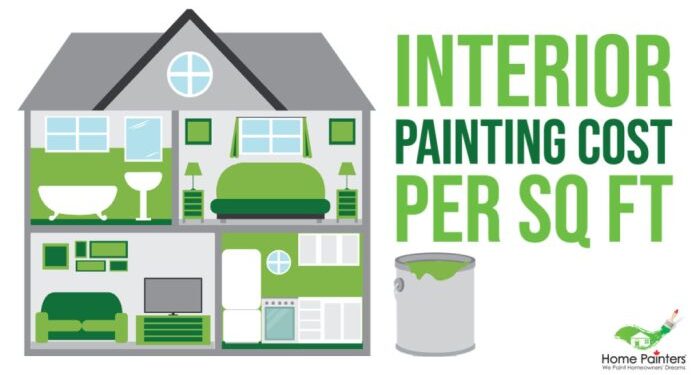Diving into the realm of house painters, this introduction aims to provide a comprehensive overview of their role, skills, services, and safety practices.
From the different types of painting projects they handle to the tools they use, this topic delves into the intricacies of the house painting industry.
. Brushes are used for cutting in and detailing, while rollers are ideal for covering large areas quickly and evenly.
Overview of House Painters
House painters play a crucial role in the construction industry by applying paint and other finishes to residential properties. They are responsible for enhancing the aesthetic appeal of homes while also providing protection against the elements.Skills and Qualifications
House painters need to have a keen eye for detail, good color sense, and excellent hand-eye coordination. They should also be physically fit as the job often involves climbing ladders and standing for long periods. A high school diploma or equivalent is typically required, and some painters may choose to complete a formal apprenticeship program to gain hands-on experience.Types of Painting Projects
House painters work on a variety of projects, including interior and exterior painting, staining, and varnishing. They may also be involved in surface preparation, such as sanding, filling holes, and applying primer. Additionally, house painters may work on new construction projects, repaints, or restoration projects to revitalize older homes.Services Offered by House Painters
House painters offer a range of services to transform the appearance of homes and protect surfaces from wear and tear. From interior painting to specialty finishes, these professionals play a crucial role in enhancing the aesthetic appeal of residential properties.Interior Painting
- Preparation of the interior space by covering furniture and floors to protect them from paint splatters.
- Repairing any cracks, holes, or imperfections on the walls before applying a fresh coat of paint.
- Selecting the appropriate paint colors and finishes to achieve the desired look and feel for each room.
- Applying primer and multiple coats of paint to ensure a smooth and even finish.
Exterior Painting
- Cleaning the exterior surfaces to remove dirt, mildew, and old paint before painting.
- Repairing any damaged areas, such as wood rot or cracks, to maintain the structural integrity of the house.
- Applying weather-resistant paint to protect the exterior from the elements and extend the lifespan of the surfaces.
- Utilizing specialized equipment, such as scaffolding and ladders, for painting hard-to-reach areas like eaves and second-story walls.
Specialty Finishes
- Offering decorative finishes like faux painting, textured finishes, and stenciling to add character and style to a space.
- Applying finishes like epoxy coatings for garage floors or metallic paints for a modern touch.
- Providing custom painting services for unique projects, such as murals or intricate designs.
Surface preparation is key to a successful paint job, as it ensures better adhesion, durability, and a professional finish.
Tools and Equipment Used by House Painters
House painters rely on a variety of tools and equipment to complete their painting projects efficiently and effectively. These tools are essential for different stages of the painting process, from preparation to finishing touches.Brushes and Rollers
Brushes and rollers are the most commonly used tools by house painters for applying paint to surfacesSprayers
Paint sprayers are used for projects that require a fine, smooth finish or for painting large surfaces like walls and ceilings. They can help painters work more quickly, but they require skill and experience to use effectively.Ladders
Ladders are essential for reaching high areas when painting walls, ceilings, or exterior surfaces. It is crucial to use the right type of ladder for the job and to follow safety protocols to prevent accidents.Maintenance Tips
- Regularly clean brushes and rollers after each use to prevent dried paint buildup.
- Store painting tools properly in a dry, cool place to protect them from damage and extend their lifespan.
- Inspect tools before each use to ensure they are in good condition and replace any worn out or damaged parts.
Safety Practices for House Painters
Ensuring safety is paramount for house painters to prevent accidents and injuries on the job. Here are some common safety practices to follow:Identifying Common Safety Hazards
- Avoiding slippery surfaces due to wet paint or cleaning solutions.
- Beware of tripping hazards such as paint cans, drop cloths, or tools.
- Be cautious of working near electrical outlets or wires.
- Watch out for unstable ladders or scaffolding.
Importance of Personal Protective Equipment (PPE)
Wearing proper PPE is essential to protect yourself from potential harm while painting. Some examples of PPE include:-
Safety goggles to protect eyes from splashes or fumes.
-
Respirators to prevent inhalation of paint fumes.
-
Gloves to shield hands from chemicals and sharp objects.
-
Protective clothing to cover skin from exposure to paint or solvents.
Guidelines for Safe Ladder Usage
Working at heights can be risky, so it's crucial to follow safe ladder practices:- Inspect the ladder for any defects or damage before use.
- Ensure the ladder is stable and placed on a level surface.
- Avoid overreaching while on the ladder to maintain balance.
- Use the "three-point contact" rule - two hands and one foot, or two feet and one hand on the ladder at all times.














